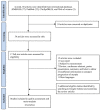Coronavirus disease 2019 outbreak and associated public health measures increase the progression of myopia among children and adolescents: Evidence synthesis
- PMID: 35315522
- PMCID: PMC9115422
- DOI: 10.1111/opo.12976
Coronavirus disease 2019 outbreak and associated public health measures increase the progression of myopia among children and adolescents: Evidence synthesis
Abstract
Purpose: Although studies have suggested that the coronavirus disease 2019 (COVID-19) outbreak increased myopia progression, they had different settings and analysis methods. This study compared myopia progression before and during the COVID-19 outbreak using meta-analysis.
Methods: Relevant literature was searched on EMBASE, PubMed, ClinEpiDB and Web of Science and reviewed until 8 October 2021. The Newcastle-Ottawa Scale was used to evaluate the quality of the original studies. The mean difference of change in spherical equivalent refraction (SER) was used for evaluation before and during the COVID-19 pandemic.
Results: The meta-analysis included eight studies with 773, 797 individuals aged 5-18 years. Pooled analysis indicated that the mean difference of annual myopia progression during the pandemic was 0.41 D higher (95% confidence interval [CI]: 0.35-0.48, p < 0.01) than before the pandemic. Subgroup analysis using cycloplegic (mean difference, 0.30 D; 95% CI, 0.22-0.38; p < 0.01) or noncycloplegic refraction (mean difference, 0.60 D; 95% CI, 0.27-0.93; p < 0.01) indicated that the mean difference of annual myopia progression during COVID-19 significantly increased in both refractive measurements.
Conclusion: Our findings demonstrated that the COVID-19 pandemic accelerated myopic progression compared to the past. Government policies are urgently required to prevent and control myopia progression.
Keywords: COVID-19; meta-analysis; myopia pandemic; optometrist; public health.
© 2022 College of Optometrists.
Conflict of interest statement
There is no conflict of interest relevant to this paper. The authors received no financial support for the study.
Figures



Similar articles
-
Pediatric Myopia Progression During the COVID-19 Pandemic Home Quarantine and the Risk Factors: A Systematic Review and Meta-Analysis.Front Public Health. 2022 Jul 22;10:835449. doi: 10.3389/fpubh.2022.835449. eCollection 2022. Front Public Health. 2022. PMID: 35937221 Free PMC article.
-
Development and progression of myopia in children during the COVID-19 pandemic in urban area in Turkey.Int Ophthalmol. 2023 Oct;43(10):3823-3829. doi: 10.1007/s10792-023-02824-w. Epub 2023 Jul 27. Int Ophthalmol. 2023. PMID: 37498447
-
Systematic Review and Meta-Analysis on the Impact of COVID-19 Pandemic-Related Lifestyle on Myopia.Asia Pac J Ophthalmol (Phila). 2022 Sep 1;11(5):470-480. doi: 10.1097/APO.0000000000000559. Asia Pac J Ophthalmol (Phila). 2022. PMID: 36179338
-
Comparison of myopia progression among Chinese schoolchildren before and during COVID-19 pandemic: a meta-analysis.Int Ophthalmol. 2023 Oct;43(10):3911-3921. doi: 10.1007/s10792-023-02777-0. Epub 2023 Jun 30. Int Ophthalmol. 2023. PMID: 37389764 Review.
-
Myopia Progression during the COVID-19 Era: A Systematic Review and Meta-analysis.Semin Ophthalmol. 2023 Aug;38(6):537-546. doi: 10.1080/08820538.2023.2168490. Epub 2023 Feb 2. Semin Ophthalmol. 2023. PMID: 36734046
Cited by
-
The Impact of the COVID-19 Pandemic on Myopia Progression in Children: A Systematic Review.Cureus. 2022 Aug 26;14(8):e28444. doi: 10.7759/cureus.28444. eCollection 2022 Aug. Cureus. 2022. PMID: 36176879 Free PMC article. Review.
-
Evidence linking COVID-19 and the health/well-being of children and adolescents: an umbrella review.BMC Med. 2024 Mar 13;22(1):116. doi: 10.1186/s12916-024-03334-x. BMC Med. 2024. PMID: 38481207 Free PMC article.
-
Paediatric myopia shift during the COVID-19 pandemic home quarantine: a systematic review and meta-analysis.BMJ Paediatr Open. 2022 Dec;6(1):e001755. doi: 10.1136/bmjpo-2022-001755. BMJ Paediatr Open. 2022. PMID: 36645798 Free PMC article.
-
Baseline metrics that may predict future myopia in young children.Ophthalmic Physiol Opt. 2023 May;43(3):466-481. doi: 10.1111/opo.13113. Epub 2023 Mar 9. Ophthalmic Physiol Opt. 2023. PMID: 36892148 Free PMC article.
-
Myopia in elementary school students in Eastern China during the COVID-19 pandemic.Front Public Health. 2023 Jun 21;11:1167379. doi: 10.3389/fpubh.2023.1167379. eCollection 2023. Front Public Health. 2023. PMID: 37415713 Free PMC article.
References
-
- Bourne RR, Stevens GA, White RA, Smith JL, Flaxman SR, Price H, et al. Causes of vision loss worldwide, 1990‐2010: a systematic analysis. Lancet Glob Health. 2013;1:e339–49. - PubMed
-
- Takashima T, Yokoyama T, Futagami S, Ohno‐Matsui K, Tanaka H, Tokoro T, et al. The quality of life in patients with pathologic myopia. Jpn J Ophthalmol. 2001;45:84–92. - PubMed
Publication types
MeSH terms
LinkOut - more resources
Full Text Sources
Medical
Miscellaneous

